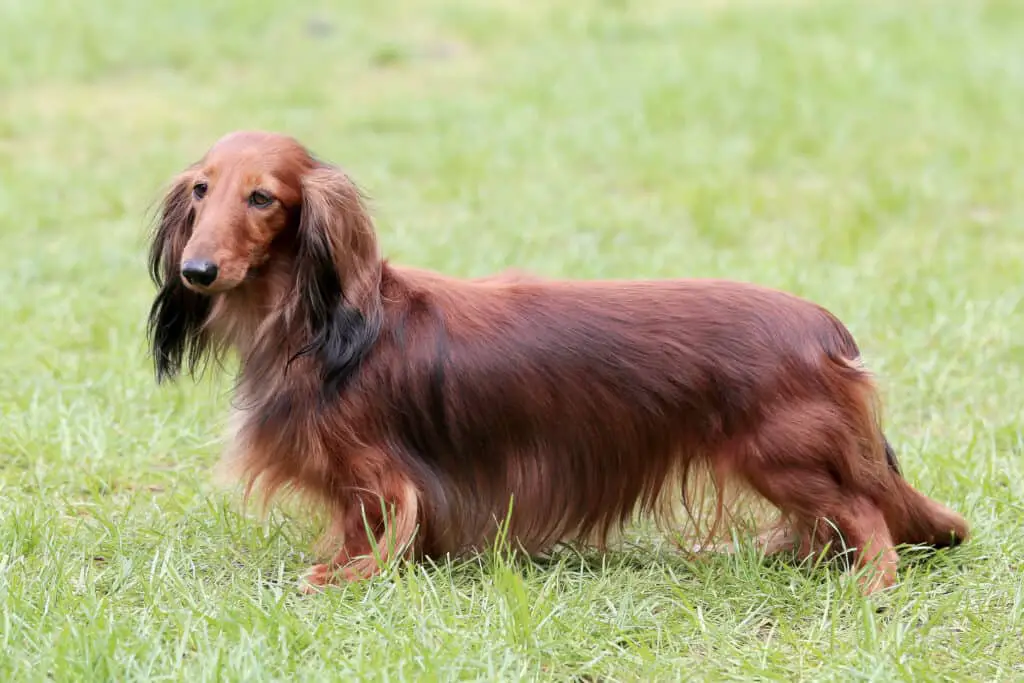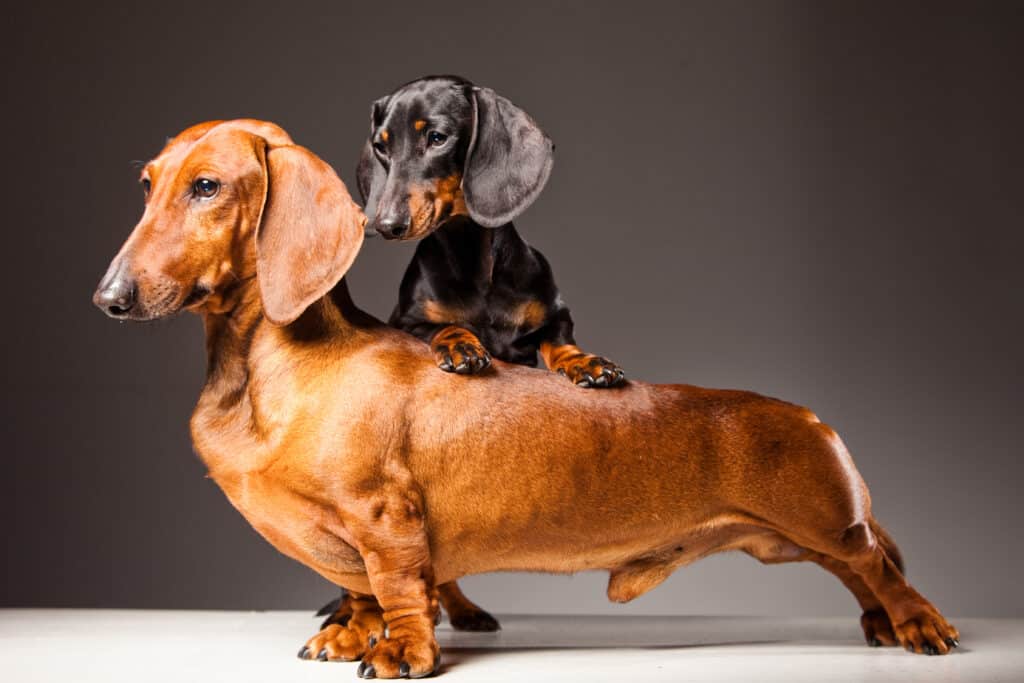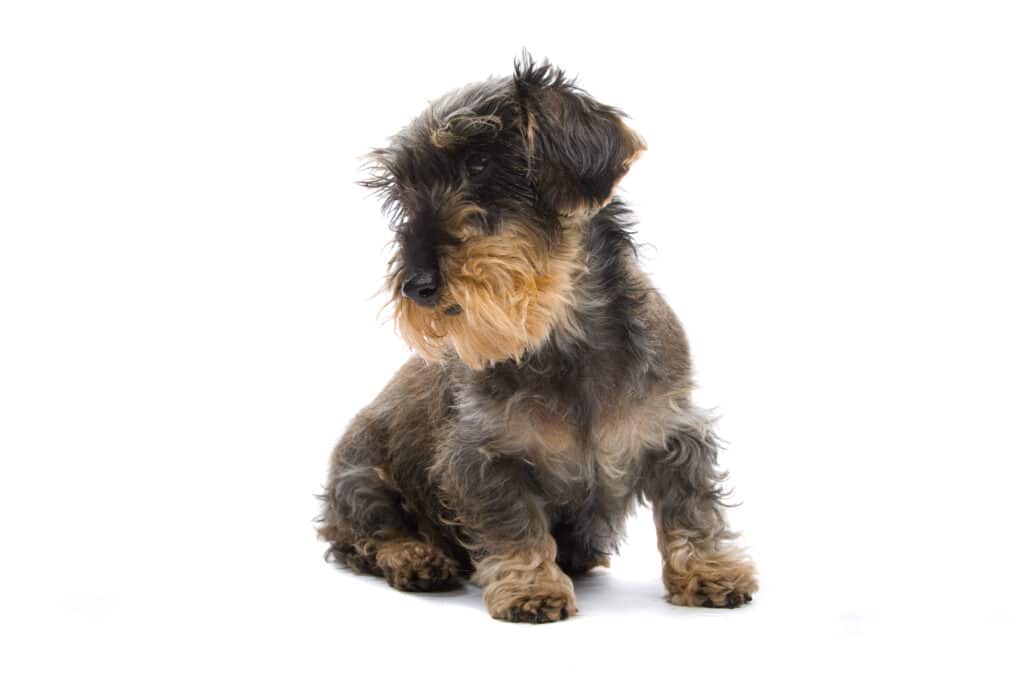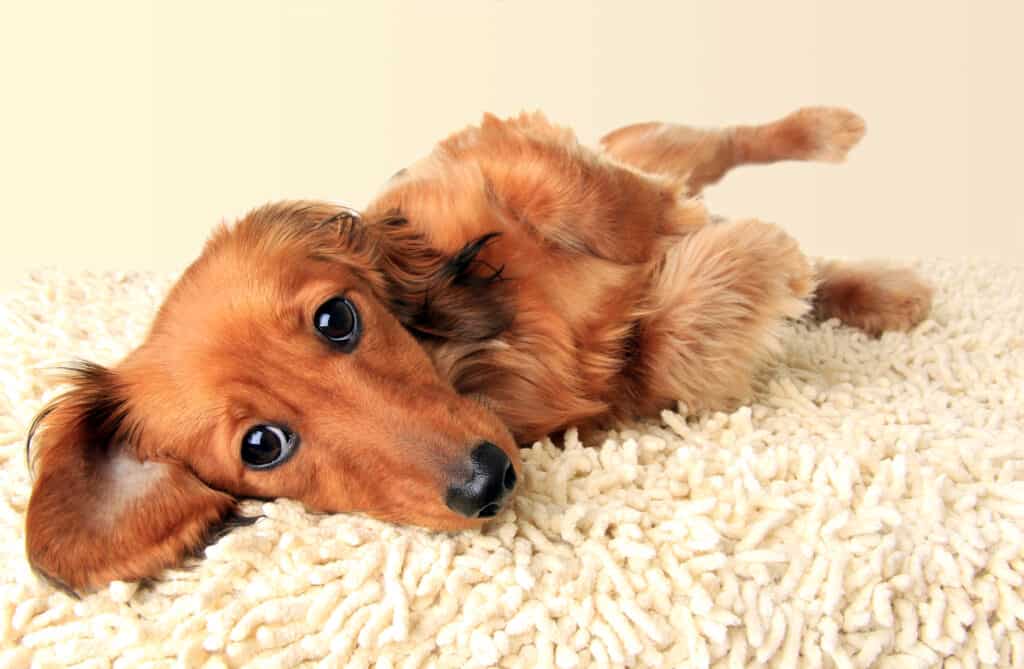Our website is supported by our users. We sometimes earn money when you click an affiliate link and make a purchase. This is at no extra cost to you and helps us to create quality content. For all that have shown us such wonderful support, we thank you from the bottom of our hearts!
The Dachshund, a small dog breed with a distinctive long body and short legs, has its roots deeply embedded in German history.
Originally bred to hunt badgers, these dogs have a courageous and curious nature that belies their size.
Today, Dachshunds are cherished as family pets, known for their loyal and playful demeanor.
Their history spans over three centuries, marking them as one of the most venerable and storied dog breeds.

In appearance, Dachshunds come in two sizes, standard and miniature, to suit different needs and lifestyles.
They feature three coat varieties: smooth, long-haired, and wire-haired.
Each type requires different grooming approaches but consistently showcases the breed’s iconic look.
Dachshunds carry a proud poise and an intelligent expression, making them a beloved subject in art and culture.
Key Takeaways
- Dachshunds have a unique shape and were originally bred for hunting badgers in Germany.
- Available in standard and miniature sizes, they have three coat varieties and require specific grooming.
- This breed is known for being a loyal companion, making an excellent family dog with the right training.
History of the Dachshund
The Dachshund, affectionately known as the wiener dog, has a storied history rooted in Germany.
Your interest in this breed likely extends beyond their charming appearance to their origins as a hunting dog.
Initially developed in the late 17th century, the Dachshund’s elongated body and short legs made them particularly effective at their primary task—hunting badgers.
| Century | Development |
|---|---|
| 16th | General emergence in Germany |
| 17th | Refinement for hunting |
| Modern | Popularity as a companion animal |
Renowned for their tenacity, these dogs were not only used for hunting badgers but also other burrow-dwelling animals, earning the nickname badger dog.
As a scent hound, their keen sense of smell made them proficient at tracking, while their persistence made them invaluable to hunters.
In terms of appearance, early Dachshunds had smooth coats and could be found in a variety of colors.
Throughout their history, they’ve been celebrated not only for their physical attributes suited for digging and hunting but also for their courageous personality.
With time, your appreciation for Dachshunds might grow as you learn about their contribution to various hunting and tracking tasks.
Today’s Dachshunds, though now more commonly companions than hunters, still retain many of their ancestral traits that once made them indispensable to German hunters.
This breed was recognized as a breed by the American Kennel Club in 1885.
Dachshund Club of America, Inc. founded in 1895 promotes the health and well-being of the Dachshund breed.
Physical Characteristics of the Dachshund

The Dachshund’s distinctive physique features a long backs, short legs, and varied coat types. They most commonly have dark eyes and a deep bark.
Their size can range from standard to miniature, and they are recognized for coat colors in various shades and types.
Height Male
Standard: Typically 8-9 inches at the shoulders
Miniature: Usually 5-6 inches at the shoulders
Height Female
Standard: Generally 8-9 inches at the shoulders
Miniature: Often 5-6 inches at the shoulders
Weight Male
- Standard: Between 16-32 pounds
- Miniature: 11 pounds or under, to prevent obesity-related health issues.
Weight Female
- Standard: Ranges from 16-32 pounds
- Miniature: Should not exceed 11 pounds
Eye Colors
- You’ll find Dachshunds with expressive eyes typically in shades of brown and hazel.

Coat Colors
- The coat color of Dachshunds are diverse; you’ll see reds, blacks, chocolates, blue, sable, wild boar, black and tan, piebald, and chocolate and tan. There are other distinct colors called dapples and double dapples.
Coat Types
There are several varieties of Dachshund coats:
- Smooth Coat: Smooth Dachshunds have a short and shiny coat
- Long-Haired: Longhaired Dachshunds have elegantly flowing hair
- Wire-Haired: Wirehaired Dachshunds have a thick and coarse coat
Life expectancy
- Typically, Dachshunds have a lifespan ranging from 12 to 16 years, influencing their overall health and quality of life.
Temperament & Training of the Dachshund
Dachshunds are known for their distinctive personalities and stubborn streaks.
As a potential or current Dachshund owner, you’ll find these small dogs are energetic and playful, often with an independent nature.
They possess a deep chest and a lively energy level, hallmarks of their breeding history as hunting dogs.
Due to their small size, they are a good choice for apartment dwellers.
When it comes to temperament, Dachshunds display a mix of courage, feistiness, and affection.
They can be timid with strangers but show great friendliness and affection to their family.
Their intelligence makes them an excellent watchdog, as they’re always alert and possess a loud bark relative to their size. As always, monitor them around young children.
Training Your Dachshund
- Consistency is key in training this breed due to their determined nature.
- Patience and positive reinforcement will prove to be invaluable, as Dachshunds may show stubbornness in obedience training.
- Establish yourself as the pack leader to overcome their independent tendencies.
- Be mindful that their playfulness can turn into mischievous behavior if not properly channeled through exercise and mental stimulation.
It’s recommended to begin training early to curb undesired behaviors like barking.
Training sessions should be short to match their attention span and to maintain their interest.
Teaching them with gentle firmness and avoiding harsh corrections will help foster a stronger bond and better response to training.
Overall, understanding the patterns of their behavior and harnessing their energy into positive activities will make for a devoted and happy companion.
Health Issues of the Dachshund
Dachshunds are known for their distinctive appearance and loyal temperament, but as an owner, you should be aware of certain health issues common to this breed.
Intervertebral Disc Disease
Their unique physique with a long back and short legs makes them susceptible to Intervertebral Disc Disease (IVDD). IVDD can cause severe pain, nerve damage, and even paralysis. Regular monitoring and preventative care can reduce the risk of IVDD.
Obesity
Being mindful of your Dachshund’s weight is crucial as obesity can exacerbate spinal problems and affect overall health.
Implementing a balanced diet and regular exercise routine will support your dog’s well-being.
Epilepsy
Dachshunds may also be predisposed to certain genetic conditions such as epilepsy.
Although it can be concerning to see your puppy experience a seizure, epilepsy is often manageable with veterinary guidance.
Regular check-ups will help in early detection and treatment.
Progressive Retinal Atrophy
Progressive Retinal Atrophy (PRA) is a hereditary eye disorder that can affect Dachshunds.
This condition involves the degeneration of the retina, leading to a gradual decline in vision and, ultimately, blindness.
Regular veterinary check-ups and genetic testing are essential for early detection and responsible breeding practices to minimize the occurrence of PRA within this breed.
As for overall health problems, it’s good practice to stay updated on parasite prevention, maintaining consistent health checks to ensure your dog lives a happy, healthy life.
Educating yourself on their potential health issues will help you provide a secure and nurturing environment, championing the brave spirit and loyalty of your beloved companion.
Grooming Your Dachshund
Grooming your Dachshund not only keeps them looking their best, but it also plays an essential role in their overall health.
Regular grooming aids in controlling shedding, ensuring a healthy coat, and preventing common health issues.
Brushing:
In order to remove dead hair and skin cells be prepared for semi frequent brushing.
To manage your Dachshund’s shedding and maintain a shiny coat, brush them 2-3 times a week.
Use a bristle brush for smooth-coated and a pin brush for long-haired varieties. This brush covers both coat types.

- Smooth: Once a week with a rubber grooming mitt or bristle brush.
- Long-haired: Several times a week with a pin brush and comb, paying extra attention to tangles.
- Wire-haired: Regular use of a slicker brush and occasional stripping to remove loose undercoat.
Bathing:
Bathe your Dachshund every three months or when noticeably dirty.
Use a dog-specific shampoo and ensure you rinse thoroughly to prevent irritation.
We like this massager because it really gets the soap down through all your dog’s fur.
- Frequency: Every 3 months or as needed.
- Products: Mild dog shampoo and conditioner for their specific coat type.
Cutting fur/hair:
While Dachshunds don’t require haircuts like some breeds, long-haired Dachshunds may need a trim to prevent matting.
Never shave or cut the coat too short to protect their skin.
- Smooth: No cutting necessary.
- Long-haired: Occasional trims, especially around feet and ears.
Clipping or Grinding Nails:
Trim your Dachshund’s nails monthly to prevent discomfort and mobility issues.
You can use clippers or a nail grinder for a smoother finish.
- Check nails: Once a week.
- Trim or grind: Monthly or as needed to maintain short nails.
Clip or grind their nails as needed, usually once or twice a month (or more), being careful not to cut into the quick, which can cause bleeding.
If you accidentally cut the quick, dip their nails in Styptic Powder.
See our article on How to Grind Your Dog’s Nails or How to Clip Your Dog’s Nails Safely.
Dental care:
Brush your Dachshund’s teeth several times a week with dog-specific toothpaste and toothbrush to prevent dental diseases.
- Brushing teeth: 2-3 times a week.
- Dental chews: Can help reduce tartar between brushings.
Cleaning Ears:
Inspect your Dachshund’s ears weekly and clean as needed with a gentle, dog-formulated ear cleaner to prevent infections.
For an easy fix, you can use the Pet MD – Dog Ear Cleaner Wipes – Otic Cleanser for Dogs.
As dogs with floppy ears they can be prone to ear infections.
- Check ears: During weekly grooming.
- Clean: With ear cleaner and cotton ball as needed, but do not insert anything into the ear canal.
Regular grooming is not just about keeping your dog looking good—it’s vital for their health too.
Including high-quality dog food in their diet can support skin and coat health, making grooming easier.
Remember, whether it’s a hot dog day in summer or a chilly winter evening, adapting your Dachshund’s grooming routine to suit their needs is key to keeping them comfortable and happy year-round.
Owning a Dachshund
Before considering bringing a Dachshund into your life, you need to understand the financial commitment that comes with it, which includes the initial cost, ongoing maintenance, as well as where and how to find one.
Cost of Purchase
The price for a Dachshund puppy can vary widely. Factors influencing the cost include lineage, breeder reputation, and location. Expect to pay between $200 to $3,500.
Costs may be lower if you choose to adopt.
Maintenance Costs
Owning a Dachshund comes with recurring expenses.
Medical costs such as vaccinations, wellness exams, and potential back problems specific to the breed should be anticipated.
Grooming: Moderate. Short-haired Dachshunds require less grooming, while long-haired varieties may need more care.
- Special training: Fees can vary, but proper training is advisable to address stubbornness.
- Preventative care: Includes regular vaccinations and parasite control.
Adopting a Dachshund
Adoption is a cost-effective and humane option. Adoption fees are typically lower than purchasing from a breeder, averaging around $100 to $300, and often include spaying/neutering and vaccinations.
For Dachshunds needing homes, visit local shelters or Dachshund-specific rescues.

Finding Reputable Breeders
Locating a reputable breeder is crucial to ensure the health and well-being of your future pet.
A reputable breeder should:
- Provide a clean and healthy environment for the dogs.
- Show transparency about the breed’s medical history.
- Allow you to meet the puppy’s parents.
Remember that owning a Dachshund is a long-term commitment that includes both emotional and financial responsibilities.
Your diligence in these areas ensures a happy life for you and your new companion.
Frequently Asked Questions
When it comes to understanding Dachshunds, there are common inquiries prospective owners often have. These FAQs aim to clarify these aspects for you.
What are the key differences between a Standard Dachshund and a Miniature Dachshund?
The primary difference lies in size; Standard Dachshunds weigh between 16 to 32 pounds, while Miniature Dachshunds are 11 pounds or less.
A Standard Dachshund generally stands taller at 8 to 9 inches, compared to the Miniature’s 5 to 6 inches in height.
How can one determine the right Dachshund mix for their family?
When considering a Dachshund mix, examine the traits of the other breed involved to ensure compatibility with your lifestyle and family dynamics.
Assess energy levels, grooming needs, and temperament traits.
What character traits define the temperament of a Dachshund?
Dachshunds are known for their alertness and vocal nature, often barking to express excitement, territoriality, or anxiety Dachshund Station.
Their hunting heritage equips them with courage and curiosity.
What are the essential considerations when looking to adopt a Dachshund?
When adopting a Dachshund, consider factors such as temperament, energy levels, and potential health issues.
Assess whether your living situation suits an active, sometimes stubborn breed that requires consistent training and socialization.

Can you provide an overview of the care requirements for Dapple Dachshunds?
Dapple Dachshunds, with their distinctive coat patterns, have similar care requirements to other Dachshunds.
They require regular exercise, a nutritious diet, and grooming commensurate with their coat type (smooth, longhaired, or wirehaired).
What is the average weight and price range for a Dachshund?
The average weight for a Dachshund can vary from under 11 pounds for miniatures to around 16 to 32 pounds for standards.
The price for a Dachshund may range based on factors like lineage, location, and age; typically, the range can span several hundred to a few thousand dollars.
Conclusion: Bottom Line on the Dachshund

When you consider bringing a Dachshund into your home, you’re looking at a breed with a spirited and lively temperament.
Your Dachshund will likely be a long-bodied, courageous companion, characterized by a deep chest, short legs, a tapering muzzle, and long, floppy ears.
Their coat can be smooth, long, or wire-haired and comes in a variety of colors, commonly reddish brown or black-and-tan.
You can expect your Dachshund to come in two main sizes: the standard Dachshund, which weighs between 16 to 32 pounds, and the miniature Dachshund, tipping the scales at about 8 to 11 pounds.
Their size doesn’t diminish their bold nature; they were originally bred for hunting, a task that emphasizes their tenacious spirit.
In terms of behavior, understand that their hunting heritage can lead to a stubborn streak, making training a potential challenge but not an insurmountable one.
Early socialization and consistent training can help address behavioral issues.
Your Dachshund’s health is paramount, so regular veterinary check-ups are essential to address breed-specific concerns such as spinal issues, given their unique body shape.
With proper care, they typically enjoy a life span of 12 to 14 years.
For families, individuals, and especially for those with a penchant for active, engaging pets, a Dachshund can be a delightful choice.
Just ensure you’re ready to provide the attention, care, and exercise your Dachshund will require to thrive in your life.
Please read our Legal Disclaimer







